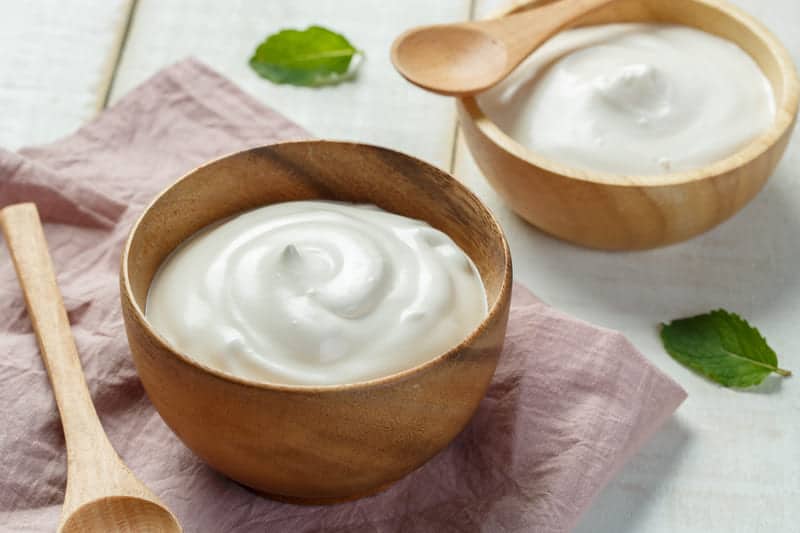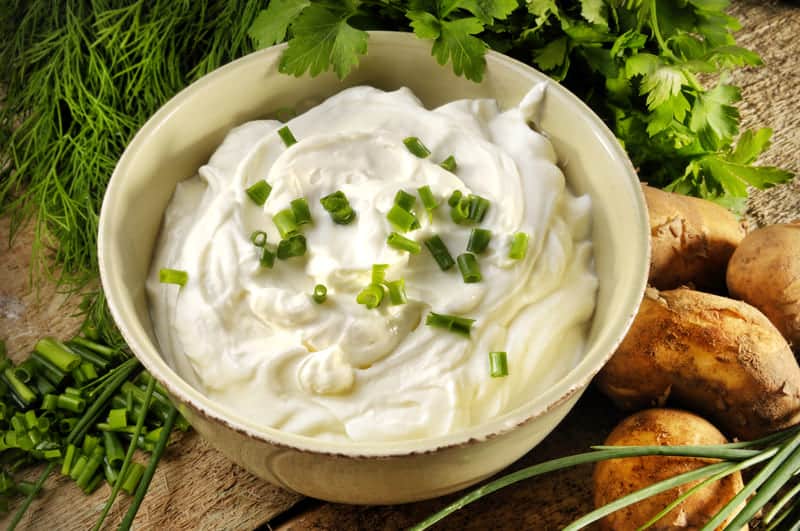There are many recipes that call for either sour cream or yogurt. And well, if you’re no culinary expert then finding the differences between them may get hard. Hence, you may replace one for another which could lead to a difference in the overall taste and texture!
The major difference between yogurt and sour cream is in the fat content and consistency. Yogurt is around 10-12% fat whereas sour cream is near about 20%. This causes a change in the overall texture as sour cream is richer and thicker.
However, that is just one difference. There are many others that you may want to learn about and flaunt in front of your other foodie friends! So, read on.
What is Yogurt?
Yogurt is one of the most common household products nowadays due to its versatility in dishes and the presence of abundant nutrients as well.
It’s a dairy product obtained by fermenting milk with specific microorganisms like Lactobacillus bulgaricus and Streptococcus thermophilus.
Due to the presence of lactic acid, yogurt has a very prominent sour and acidic taste. Hence, it blends well with various fruits and dishes.
What is Sour Cream?
On the other hand, sour cream is also a type of dairy product obtained by fermentation.
However, instead of milk, the cream is fermented with the help of specific microorganisms such as Lactococcus lactis. These microorganisms cause the production of lactic acid which makes the cream sour and acidic in taste. Hence, you call it sour cream!
Now, both sour cream and yogurt may seem quite similar. So, let’s take a close look at the other differences between the two.
Yogurt vs Sour Cream: Side-by-Side Comparison
Given below is a short table that summarizes all the major differences between both yogurt and sour cream.
| Category | Yogurt | Sour Cream |
| Ingredients Used | Milk, Lactobacillus bulgaricus, and Streptococcus thermophilus (for fermentation) | Heavy cream, Lactococcus lactis (for fermentation) |
| Fat Content | Contains 10-12% fat content | Contains 20% fat content |
| Taste and Texture | Sour and acidic flavor with a bland texture | Tangy and acidic flavor with a richer and creamier texture |
| Food Application | Variety of uses in recipes | Used as a condiment or for dips |
| Shelf Life | Lasts for around 1-2 weeks | Lasts for up to 3 weeks |
| Health Factor | Low in calories (59 per 100 gm) | High in calories (193 per 100 gm) |
How is Sour Cream Different from Yogurt?
Many people often confuse sour cream with yogurt as they’re unaware of the differences between the two. However, if you take a look at their texture and taste, you’d know that they’re not exactly the same. So, if you are confused too, I’ve covered the differences in detail below.
Production method
Right from the start, yogurt and sour cream show dissimilarities. Both are fermentation products, however, the ingredients used aren’t the same.
Yogurt is made out of the fermentation of milk which leads to its slightly thin consistency. On the other hand, sour cream is made out of the fermentation of any type of cream such as heavy cream. This makes it much richer and flavorful.
The microorganisms used in the fermentation process also vary in both. Lactobacillus bulgaricus and Streptococcus thermophilus are used for yogurt, however, for sour cream, Lactococcus lactis is used.
Texture, taste, and fat content
Another thing that separates sour cream from yogurt is its overall fat content.
As sour cream comes from the fermentation of cream instead of milk, it has a higher fat content of 20%. Yogurt is made out of milk and has almost half the fat content (10-12%) of sour cream.
The fat content definitely affects the texture and taste of both dairy products.
For instance, sour cream provides a richer texture. And the sour flavor is also more defined here. Conversely, yogurt’s texture is slightly bland and thin.
Food application
Yogurt has extensive usage as you can eat it raw or with some mixed fruits too.
Moreover, you can also use it in many dishes like stuffed eggs and salads. Yogurt types, such as Greek Yogurt, are also very popular today.
On the other hand, sour cream isn’t as common as yogurt.
Still, many people use it more like a condiment rather than the main dish. For instance, you can add it to soups or dips to get a thicker and creamier texture.
Many bakers also use sour cream for baking to make moist items.
Shelf life
Yogurt and sour cream have a very short shelf life because they’re fermented dairy products and require a proper environment to remain fresh.
If you keep them improperly, they may spoil due to the growth of bacteria.
If you refrigerate them, yogurt can last for up to 2 weeks. Moreover, here, sour cream definitely wins as it can last for up to three weeks!
Can You Substitute Yogurt for Sour Cream?
You may have one main question regarding substituting yogurt for sour cream. The answer is yes, you may substitute yogurt for sour cream. However, you may notice some differences.
Yogurt has a softer taste and texture while sour cream is richer and creamier. I recommend using sour cream where the recipe calls for a richer texture. For example, using yogurt instead of sour cream in soups may not be a good idea as yogurt may curdle.
On the other hand, it’s acceptable to substitute yogurt for sour cream in bakery products or dips. The ratio remains 1:1 here!
Related Questions
Is sour cream sourer than yogurt?
Both yogurt and sour cream have a tangy, acidic taste. However, in the case of sour cream, the sour taste is definitely more noticeable because sour cream has a thicker consistency which leads to a more flavorful taste.
What are sour cream and yogurt both examples of?
Sour cream and yogurt are fermented dairy products made from cream and milk respectively.
Can yogurt replace sour cream in cheesecake?
Yes, it is okay to use yogurt in place of sour cream for cheesecakes. However, the end product may not have a very fluffy and rich texture.
Can you mix sour cream and yogurt?
Yes, you can mix sour cream and yogurt together for anything you like!
Final Thoughts
Yogurt and sour cream are sides of the same coin. They’ve almost the same preparation and fermentation method, along with a similar tangy taste.
Yet, some factors such as ingredients and fat content give both of them different applications in food!






2 comments
Thanks so much for that tutorial. I was in the middle of my cake preparation and realized that I had yogurt instead of sour cream!
This helps a lot! No confusion! 🙂
I am glad, it was helpful.